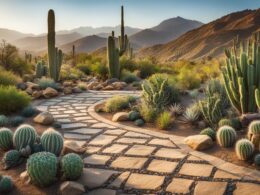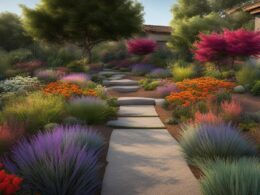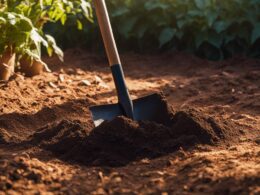Xeriscape gardens offer a comprehensive approach to landscaping that prioritizes water conservation. By following the principles of xeriscape landscaping and establishing a proper watering schedule, you can create a lush and green landscape while saving water, money, and time.
Key Takeaways
- Xeriscape gardens are designed to conserve water through efficient landscaping practices.
- Proper planning and design are crucial for a water-efficient landscape.
- Conducting a soil analysis and preparation can optimize water absorption.
- Selecting appropriate plants, particularly native species, helps conserve water.
- Efficient irrigation techniques, such as drip irrigation, minimize water waste.
Planning and Design for a Water-Efficient Landscape
Creating a water-efficient landscape begins with a well-thought-out landscape design. By carefully planning and designing your outdoor space, you can not only conserve water but also enhance the appearance and functionality of your landscape. Consider factors such as the existing structures, trees, shrubs, and grass areas in your yard. Think about how you want your landscape to look and function, as well as your budget and the maintenance required.
When it comes to planning and design, seeking guidance from local professionals such as landscape architects, designers, nurserymen, and county extension agents can be helpful. They can provide valuable insights and expertise based on your specific requirements and the conditions in your region. Collaborating with these professionals can ensure that your water-efficient landscape is tailored to your individual needs.
Implementing Your Landscape Design
“A well-designed landscape can be implemented gradually over several years to fit your schedule and budget.”
Implementing your landscape design doesn’t have to be a daunting task. In fact, it can be done gradually over several years to fit your schedule and budget. Start by focusing on key areas or elements that will have the most impact on water conservation. This can include replacing water-intensive turf areas with xeriscape plantings, incorporating efficient irrigation systems, or installing water-saving features such as rainwater harvesting systems.
Remember, the goal is to create a sustainable and beautiful landscape that minimizes water usage while maximizing the enjoyment and functionality of your outdoor space. With proper planning and design, you can achieve a water-efficient landscape that not only conserves water but also enhances the overall aesthetic appeal of your property.
- Consider the existing structures, trees, shrubs, and grass areas in your yard.
- Think about factors such as the landscape budget, appearance, function, maintenance, and water requirements.
- Seek guidance from local professionals such as landscape architects, designers, nurserymen, and county extension agents.
- Implement your landscape design gradually over several years, focusing on key areas or elements that will have the most impact on water conservation.
Soil Analysis and Preparation for Water Absorption
One of the key steps in creating a water-efficient xeriscape garden is conducting soil analysis and preparing the soil for optimal water absorption. By understanding the composition and properties of your soil, you can ensure that it has the ability to retain and deliver water to your plants effectively.
Adding organic matter to the soil is a crucial part of soil preparation. Organic materials such as shredded pine bark, peat, and rice hulls can improve the soil’s water-holding capacity, enabling it to absorb and store water more efficiently. To achieve the best results, it is recommended to till in 4 to 6 inches of organic material in shrub and flower bed areas.
By incorporating organic matter into the soil, you create a rich and fertile environment for plants to thrive. The increased water absorption capacity of the soil ensures that the plants receive adequate moisture, reducing the need for frequent watering. This not only conserves water but also saves you time and effort in maintaining your xeriscape garden.
Soil analysis and preparation are essential steps in creating a successful xeriscape garden. By taking the time to understand your soil and enhance its water absorption capabilities, you can set the foundation for a water-efficient and thriving landscape.
Selecting Appropriate Plants for a Xeriscape Garden
When it comes to creating a water-efficient xeriscape garden, selecting the right plants is essential. By choosing appropriate plants that are native to your region and naturally adapted to the local soil and climate, you can ensure a thriving and sustainable landscape. Native plants generally have lower water demands, are more adaptable to local conditions, and require less maintenance compared to non-adapted exotic plants.
One of the benefits of using native plants in your xeriscape garden is their natural ability to tolerate local climate conditions. These plants have evolved over time to thrive in specific regions, making them more resilient and less dependent on supplemental watering. Additionally, native plants have adapted to the local soil composition, which means they are better at absorbing and utilizing available water efficiently.
When selecting plants for your xeriscape garden, consider their water demands. Some plants, such as cacti and succulents, are naturally drought-tolerant and require minimal watering. Others, like wildflowers and ornamental grasses, can add color and texture to your landscape without excessive water needs. By choosing a variety of plants with different water requirements, you can create a diverse and visually appealing xeriscape garden.
Benefits of selecting appropriate plants:
- Lower water demands
- Increased adaptability to local conditions
- Reduced pest problems
- Less fertilizer needs
Incorporating native plants and well-adapted exotic plants into your xeriscape garden can result in a beautiful and sustainable landscape that conserves water. Consult local resources, such as recommended adapted landscape plant lists and advice from nursery professionals and county extension agents, to help guide your plant selection process.
Efficient Irrigation Techniques for Water Conservation
Efficient irrigation techniques play a vital role in conserving water in a xeriscape garden. By implementing the right irrigation methods, you can maximize water usage and minimize waste. Two commonly used techniques are point source drip irrigation and drip irrigation on a grid.
In point source drip irrigation, each individual plant has its own emitter or two placed at the base, delivering water directly to the plant’s roots. This method is particularly suitable for landscapes with well-spaced plantings, as it ensures that water is delivered efficiently to each plant, avoiding water loss through evaporation or runoff.
Drip irrigation on a grid provides full ground coverage over the entire planting bed. Special tubing with in-line emitters spaced every 12 inches is used to water every square foot of the garden bed. This method ensures that water is evenly distributed, reaching all the plants in the bed and reducing water waste.
Both point source drip irrigation and drip irrigation on a grid can be effective approaches to water conservation in a xeriscape garden. By using these efficient irrigation techniques, you can save water and help your plants thrive while still maintaining a beautiful and sustainable landscape.
How Can I Incorporate a Watering Schedule into a Sustainable Xeriscape Garden?
Incorporating a watering schedule into a sustainable xeriscape garden is essential for conserving water. By following sustainable xeriscaping tips, such as grouping plants with similar water requirements and using mulch to retain moisture, you can create a low-maintenance garden that thrives on minimal watering.
Mulching to Conserve Moisture and Reduce Weeds
Mulching is a key practice in a xeriscape garden to help conserve moisture and reduce weed growth. By applying a layer of mulch to the soil surface around plants, you can create a barrier that helps retain moisture and prevent evaporation. One of the most effective types of mulch is wood mulch, which can be made from materials like pine bark, compost, and wood chips.
Wood mulch has several benefits for your xeriscape garden. Firstly, it acts as an insulating layer, keeping the soil cooler in the summer and warmer in the winter. This helps to create a more stable environment for plant roots. Secondly, wood mulch can significantly reduce weed growth by blocking sunlight and preventing weed seeds from germinating. This means less time spent on weeding and more time enjoying your garden.
When applying wood mulch, it’s important to lay down a generous layer, about 3-5 inches thick. This depth provides adequate coverage and helps to suppress weed growth effectively. Additionally, be sure to leave a small gap around the base of plants to prevent the mulch from directly touching the stems, as this can promote rot and disease. Regularly replenishing your wood mulch every two or three years is recommended to ensure its effectiveness and appearance.
Advantages of Wood Mulch:
- Retains moisture in the soil, reducing the need for frequent watering
- Helps regulate soil temperature, protecting plant roots
- Suppresses weed growth, minimizing the competition for nutrients
- Enhances the visual appeal of your xeriscape garden
- Breaks down over time, adding organic matter to the soil
“Adding a layer of wood mulch to your xeriscape garden can make a significant difference in water conservation and weed control. It’s a simple yet effective practice that can help your plants thrive while minimizing water usage and maintenance.”
Conclusion
Establishing a watering schedule for xeriscape gardens is essential in promoting water conservation. By following the principles of xeriscape landscaping, planning a water-efficient landscape, analyzing and preparing the soil, selecting appropriate plants, using efficient irrigation techniques, and mulching to conserve moisture, you can effectively save water, money, and time.
When it comes to determining the watering schedule for your xeriscape garden, several factors should be considered, such as the water requirements of the plants, the type of soil, and the local climate. To encourage deeper root growth and increase drought tolerance, it is recommended to water deeply and infrequently.
With proper planning and maintenance, xeriscape gardens can flourish even in the toughest environments while minimizing water usage. By embracing the principles of xeriscape landscaping and implementing a thoughtful and well-designed watering schedule, you can create a beautiful and sustainable outdoor space that conserves water and benefits the environment.














